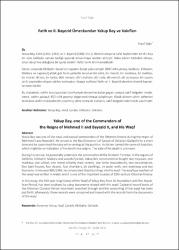Fatih ve II. Bayezid Ümerâsından Yakup Bey ve Vakıfları
Künye
SAĞIR, Yusuf. "Fatih ve II. Bayezid Ümerâsından Yakup Bey ve Vakıfları." Vakıflar Dergisi, 46 (2016): 47-81.Özet
Yakup Bey, Fatih (1451-1481) ve II. Bayezid (1481-1512) dönemi derya ve sahil beylerinden biridir. Kısa
bir süre Gelibolu sancak beyliği yaparak donanmaya nezâret etmiştir. Baba adının Abdullah olması,
onun devşirme olduğuna bir işaret olabilir. Vefat tarihi bilinmemektedir.
Görevi sırasında Kilitbahir Kalesi’nin inşaatını bizzat yüklenmiştir. 889/1484 yılında, Gelibolu, Kilitbahir,
Malkara ve Lapseki/Çardak gibi farklı yerlerde bulunan bir câmi, bir mescit, bir medrese, bir mektep,
bir imaret, iki han, bir türbe, dört hamam, dört mahzen, dört oda, altı menzil, altı su kuyusu, bir suyolu
ve iki çeşmeden oluşan vakfını kurmuştur. Arapça vakfiyesi Fatih ve II. Bayezid devrinin önemli kaynaklarından
biridir.
Bu makalede, vakfın kuruluşundan Cumhuriyet dönemine kadar geçen süreçte vakıf belgeleri incelenerek,
vakfın yaklaşık 450 yıllık geçmişi değerlendirilmeye çalışılmıştır. Klasik dönem tahrir defterleri
taranarak vakfın muhasebeleri çıkarılmış; daha sonra da bunların, vakıf belgelerinden takibi yapılmıştır. Yakup Bey was one of the naval and coastal commanders of the Ottoman Empire during the reigns of
Mehmed II and Bayezid II. He served as the Bey (Governor) of Sancak of Gelibolu (Gallipoli) for a short
time and he supervised the navy while serving at this position. His father carried the name of Abdullah,
which might be an indication of his devshirme origins. The date of his death is unknown.
During his service, he personally undertook the construction of the Kilitbahir Fortress. In the regions of
Gelibolu, Kilitbahir, Malkara and Lapseki/Çardak, Yakup Bey constructed or bought two mosques, one
madrasa, one school, one imaret (charity meal center), one türbe (mausoleum), two caravanserais,
four bath houses, four depots, four chambers, six dwellings, six water wells, one waterway and two
fountains. In the year 889/1484, he consecrated these buildings into his waqf. The waqfiyya (vakfiye) of
this waqf was written in Arabic and it is one of the important sources of 15th century Ottoman history.
In this essay, the 450-year long history of the Waqf of Yakup Bey, from its foundation until the Republican
Period, has been analyzed by using documents related with this waqf. Cadastral record books of
the Ottoman Classical Period have been searched through and the accounting of the waqf has been
put forth; afterwards, these records were compared and traced with the records from the documents
of the waqf.
Bağlantı
https://www.vgm.gov.tr/vgm/vgmdergi/vakiflardergisi/sayi46/files/assets/basic-html/index.html#1https://hdl.handle.net/11352/2599
Koleksiyonlar
- Vakıflar Dergisi [825]



















